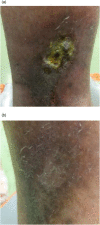Feasibility of incompetent perforator vein excision using stab avulsion
- PMID: 35318865
- PMCID: PMC9168896
- DOI: 10.1177/02683555221081816
Feasibility of incompetent perforator vein excision using stab avulsion
Abstract
Objectives: Whether incompetent perforator veins (IPVs) require treatment remains controversial. We retrospectively evaluated the feasibility of IPV excision performed using the stab avulsion technique without ligation and sutures in patients undergoing endovenous ablation (EA).
Methods: This was a single-center, retrospective, observational cohort study. EA was performed in 1503 consecutive patients, including 33 patients with ulcers, between December 2014 and May 2021. Varicectomy was performed using the stab avulsion technique; IPV cases were included.
Results: Stab avulsion was performed at a mean number of 11.4 ± 7.8 sites. No deep vein thromboses or pulmonary emboli were noted. The incidence of nerve injury was 0.3%. All 33 (100%) patients with ulcers achieved healing by 1 year (median: 55.5 days; range: 13-365 days).
Conclusions: IPV excision via stab avulsion may be a viable option for treating varicose veins and ulcers. This technique offers multiple advantages, including simplicity, safety, and reduced healthcare costs.
Keywords: Endovenous ablation; nerve injury; stab avulsion; varicose veins; venous thrombosis.
Conflict of interest statement
Figures
Similar articles
-
Endovenous ablation of incompetent perforating veins is effective treatment for recalcitrant venous ulcers.J Vasc Surg. 2011 Sep;54(3):737-42. doi: 10.1016/j.jvs.2011.02.068. Epub 2011 Jun 12. J Vasc Surg. 2011. PMID: 21658887
-
The effect of endovenous laser ablation of incompetent perforating veins and the great saphenous vein in patients with primary venous disease.Eur J Vasc Endovasc Surg. 2015 May;49(5):574-80. doi: 10.1016/j.ejvs.2015.01.013. Epub 2015 Mar 5. Eur J Vasc Endovasc Surg. 2015. PMID: 25754773
-
Endovenous laser ablation of great saphenous vein and perforator veins improves venous stasis ulcer healing.Ann Vasc Surg. 2013 Oct;27(7):932-9. doi: 10.1016/j.avsg.2012.09.014. Epub 2013 May 24. Ann Vasc Surg. 2013. PMID: 23711972
-
Superficial vein surgery and SEPS for chronic venous insufficiency.Semin Vasc Surg. 2005 Mar;18(1):41-8. doi: 10.1053/j.semvascsurg.2004.12.011. Semin Vasc Surg. 2005. PMID: 15791553 Review.
-
Endovenous laser ablation: A comprehensive review.Phlebology. 2020 Oct;35(9):656-662. doi: 10.1177/0268355520937619. Epub 2020 Jul 6. Phlebology. 2020. PMID: 32631172 Review.
References
-
- Rutherford EE, Kianifard B, Cook SJ, et al. Incompetent perforating veins are associated with recurrent varicose veins. Eur J Vasc Endovasc Surg 2001; 21: 458–460. - PubMed
-
- Lin Y-N, Hsieh T-Y, Huang S-H, et al. Management of venous ulcers according to their anatomical relationship with varicose veins. Phlebology 2018; 33: 44–52. - PubMed
-
- Hauer G. Endoscopic subfascial discussion of perforating veins-preliminary report. VASA 1985; 14: 59–61 (in German). - PubMed
-
- Rigby KA. Vascular surgical society of Great Britain and Ireland abstracts. Br J Surg 2002; 89: 507–526.
Publication types
MeSH terms
LinkOut - more resources
Full Text Sources
Medical


